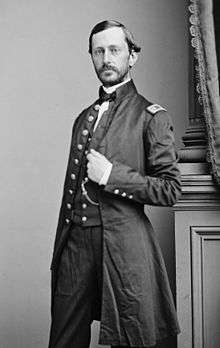Robert S. Williamson
| Robert Stockton Williamson | |
|---|---|
 Robert S. Williamson | |
| Born |
January 21, 1825 Oxford, New York |
| Died |
November 10, 1882 (aged 57) San Francisco, California |
| Place of Burial | San Francisco Masonic Cemetery |
| Allegiance |
Union |
| Service/branch |
Union Army |
| Years of service | 1848–1882 |
| Rank |
|
| Unit | Corps of Engineers |
| Battles/wars | |
Robert Stockton Williamson (January 21, 1825 – November 10, 1882) was an American soldier and engineer, noted for conducting surveys for the transcontinental railroad in California and Oregon.
Early life and career
Williamson was born in Oxford, New York and lived in Elizabeth, New Jersey. He was named after Commodore Robert F. Stockton, a family friend. He joined the Navy in 1843 as a master's mate under Stockton on the USS Princeton, the first screw-driven steam ship in the Navy. Williamson was detached from the ship 10 days before one of its guns exploded, killing several people.
It was through Stockton's influence that Williamson was appointed to the United States Military Academy. He graduated fifth in his class in 1848 and appointed a 2nd Lieutenant in the Corps of Topographical Engineers. He was assigned to conduct surveys for proposed routes for the transcontinental railroad in California and Oregon. He was then assigned to the staff of the commanding general of the Department of the Pacific, and was the engineer in charge of the military roads in southern Oregon.[1]
Civil War
At the outbreak of the American Civil War, Williamson was the Chief Topographical Engineer in North Carolina and was brevetted Major for service at the Battle of New Bern, and brevetted a Lieutenant Colonel at the Battle of Fort Macon. He was then assigned as Chief Topographical Engineer for the Army of the Potomac. Williamson returned to California as the Chief Topographical Engineer of the Department of the Pacific.
In 1863, Williamson transferred to the Corps of Engineers and served as lighthouse engineer for the Pacific Coast. He also worked on defenses and harbors along the coast.
Postbellum
He retired from the Army due to illness as a Lieutenant Colonel in 1882. Williamson had suffered from bad health for the last 20 years of his life and died of tuberculosis in San Francisco, California. He was buried at the Masonic Cemetery in San Francisco. Mount Williamson in California, a western woodpecker, the Williamson's sapsucker, and Williamson Mountain and the Williamson River in Oregon are named in his honor.[2]
References
- ↑ "West Point in the Making of America". Smithsonian Institution. Retrieved 2009-05-31.
- ↑ McArthur, Lewis A.; McArthur, Lewis L. (2003) [1928]. Oregon Geographic Names (7th ed.). Portland, Oregon: Oregon Historical Society Press. pp. 1043–1044. ISBN 978-0875952772.
- 14th Annual Reunion of the Association of Graduates of the United States Military Academy at West Point, New York, June 12, 1883. East Saginaw, Michigan: Courier Publishing Co. 1883.